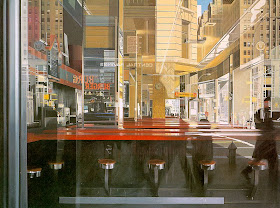The paintings of photorealist Richard Estes (born 1932) are currently being featured in a major retrospective at the Smithsonian American Art Museum in Washington.
 |
| Richard Estes, "Murano Glass," 1976, 24 x 36 inches, oil |
Calling him a photorealist is a little misleading. Although he uses photos as a source for his work, many of his paintings combine information from several different photos, and he doesn't paint over traced photographic projections. In the case of "Murano Glass," above, the reflection that you see in the window isn't actually visible in that particular store window. He had to construct the scene.
 |
| Richard Estes, "The Candy Store," 1969, 47 x 68 inches |
Painting a reflection in a shop window presents a fascinating visual challenge. Usually the street reflection is most visible in the dark areas of the window. Wherever the reflection crosses an object seen through the window, the colors and values are added to each other, such as in the slanting yellow sign.
Estes delights in creating a puzzle out of all the overlapping layers of information. In the painting above, the interior ceiling forms slant across reflections of buildings in the upper right. Some signs, such as "Burger" are reflected twice by parallel planes of glass or mirrors.
Painting reflections + transparency from observation rather than from photos is a much greater challenge because one has to overcome the effects of stereoscopic vision and focal depth. Whereas a camera will compress reflections and transparencies into a single plane, our eyes and brains separate them, so that it's almost impossible to perceive the combined effects of transparency and reflection at the same time.
-----
Here's an example where I try an outdoor painting of reflections and transparency from observation.
Richard Estes at the Smithsonian American Art Museum through February 8.
New book related to the exhibition: Richard Estes' Realism


I saw this show a few weeks ago and it is quite amazing. I was aware of Estes work but seeing a large number of them in person is extremely inspiring, even if photo realism is not necessarily your cup of tea.
ReplyDeleteThere are also a few woodland landscapes in the show that were equally impressive and a nice counter to the cityscapes. I highly recommend it if in the area!
I met Estes years ago and he is a smart, hard working guy but these pictures seem more like the visual equivalent of sudoku puzzles than art with real vitality and humanity.
ReplyDeletePutting Estes aside, thanks for another year of wonderful, insightful posts. Your energy, curiosity and positive attitude never fail to impress. I hope you have a wonderful new year and I look forward to following you in 2015.
ReplyDeleteWow! To think of the amount of work that must have went into painting reflections and transparencies is insane! I love the first painting, absolutely beautiful! I love the nostalgic quality to the paintings. Always great seeing your art history posts, Mr. Gurney!
- Lizz
www.lizzvisions.com
Thanks for posting this. I wish I were able to come see the exhibition. I understand what David says which is what I feel about most photorealism. However, to me, Estes stands out. Largely because of the painterly approach he takes to his work. Rather than simply copying the photo square-inch-by-square-inch as does, say Ralph Goings, he starts his paintings in a very painterly way, laying in large, almost abstract shapes and then develops the whole canvas together making adjustments and changes throughout, as you said in your post. On my blog I've posted a couple of examples showing some of this.
ReplyDeleteThanks again for all your great posts! I look forward for what's to come in the new year.
I agree Allen. I was really struck by the "mark making" which is quite unique when viewed up close.It is very abstract and painterly but difficult to see in reproductions.
ReplyDeleteYour last sentence is very intruiging, James, and could require quite some painting to investigate the issues one has to deal with when painting reflections from life.
ReplyDeleteI'm writing this in my notebook as a note to self.
Those Estes paintings are outrageously complex. But as you suggest they don't have the distant, emotionally detached aspects of most photorealist paintings. Some have an old world glow about them.
ReplyDelete